

![]()
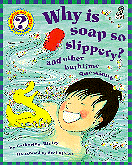
|
Why Is Soap So Slippery?
Do the Doors Open by Magic?
Catherine Ripley. Illustrated by Scot Ritchie.
Preschool - grade 4 / Ages 3 - 9.
* * * /4 (Soap)
|
excerpt:
Animals don't have bathtubs - so how do they stay clean? All sorts of ways. Believe it or not, zebras roll around in dirt to get clean! It's old skin and bugs they need to clean off. Chimps have a friend pick out the bugs and dirt from their fur, while cats use their tongues to lick themselves clean. Rhinos depend on the help of a special bird -- the bird gets to have a meal of the pesky bugs it finds on the rhino's hide. And elephants shower or bathe in dust, or in water -- without the soap!
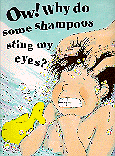 THESE TITLES ARE THE FIRST TWO in a new series from Owl called "Question and Answer Storybooks." Aimed at inquisitive preschoolers, they combine wordless picture books with introductory science lessons.
THESE TITLES ARE THE FIRST TWO in a new series from Owl called "Question and Answer Storybooks." Aimed at inquisitive preschoolers, they combine wordless picture books with introductory science lessons.
Why is Soap So Slippery? deals with such bath related questions as why some shampoos sting my eyes, how do towels dry overnight and why fingers wrinkle in the tub. The description of where toilet water travels is easy to understand. A cutaway diagram shows city house pipes connecting to other pipes that lead to a water treatment plant.
Although these may be common questions, some of the answers will be hard to grasp without background knowledge of other scientific principles. For example:

Why is soap so slippery? . . . Like all things, soap is made up of millions of molecules -- tiny pieces so small you can't see them without a microscope. When soap gets wet, water molecules free up the soap molecules so that they can slip and slide around. They slip easily onto your skin, join with the dirt, and slide the dirt right off your body, leaving you clean as a whistle.This may leave adults trying to explain molecular structures, with no assistance from the text.
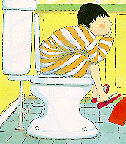
The answer to why we brush our teeth is not for the faint-of-heart:
Inside your mouth are tiny living things called bacteria. When you don't brush, food sticks to your teeth, and the bacteria eat the sugars in it. As they do, they let out waste that's full of acid strong enough to melt the hard outer coating of your teeth. Then, uh oh, the acid makes holes! By brushing your teeth, you get rid of the sugars that the bacteria like to eat.
Each answer will of course lead to more questions -- which isn't necessarily good or bad. As towels dry "the invisible water vapour floats into the air and away from the towel, until it is dry." If your child asks where the water vapour in the air goes next . . . hopefully you'll recall the information from your past science lessons or be willing to research the answer.
Outside the text is a rather simple storyline showing an Asian father bathing his preschooler. The routine includes brushing his teeth, going to the toilet, bathing, drawing on the steamy mirror then leaving so his big sister can have a turn. These pictures are charming and despite the location, we never actually see the child naked.
Recommended
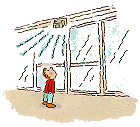 DO THE DOORS OPEN BY MAGIC? successfully answers eleven questions. "Where do apples come from in the Winter?" has a great answer about putting apples to sleep in the fall in a room without light, warmth or oxygen. "Months later, when workers took the apples out of the rooms to send to the store, they woke up fresh and crunchy." You learn something new everyday!
DO THE DOORS OPEN BY MAGIC? successfully answers eleven questions. "Where do apples come from in the Winter?" has a great answer about putting apples to sleep in the fall in a room without light, warmth or oxygen. "Months later, when workers took the apples out of the rooms to send to the store, they woke up fresh and crunchy." You learn something new everyday!
In answer to "What's behind the big doors?" we get a simplified overhead shot of the store layout. Doors works much better than Soap. The answers are fun and factual without as many red herrings. The mostly wordless picture book part is also more amusing.

We follow a black mother through the supermarket with her baby and cart-pushing preschooler.Although the youngest upsets a stacked display by removing a can near the bottom, he's the only one who remembers the milk. Other shoppers include a mix of races and ages, as well as a trendy young woman with metal crutches leaving her car in the handicapped stall. Elvis can be spotted in the produce aisle.
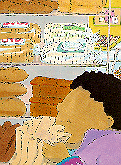
The illustrations for both books are absolutely delightful. Simple and bright watercolour work with lots of amusing details, each perfectly captures a loving family. Attentive readers may notice the Asian father and son neighbours from Soap, as the shoppers are leaving their house.
Supposedly these books are targeted at ages three and up, but the lower end of the range may get lost or bored with the scientific slant of the text. This book could "grow" with them though, working as wordless book at first, while they invent the story. As questions arise, and/or when they're older, the answers will be of more interest. However, the picture book format, simple storyline and the age of their characters will probably be an obstacle for kids over age nine.
Nevertheless, with clean interesting text, and fun artwork,
both titles are worthwhile purchases for home or school use. Do the Doors Open . . .is especially good.
Highly Recommended

A.Edwardsson works at a branch of the Winnipeg Public Library where she is in charge of the Children's department. She has a Bachelor of Education degree, Child Care Worker III certification and is a member of the Manitoba branch of the Canadian Authors Association.
To comment on this title or this review, send mail to cmeditor@mts.net.
![]()
Copyright © 1996 the Manitoba Library Association.
Reproduction for personal use is permitted only if this copyright notice
is maintained. Any other reproduction is prohibited without permission.
Published by
The Manitoba Library Association
ISSN 1201-9364
![]()